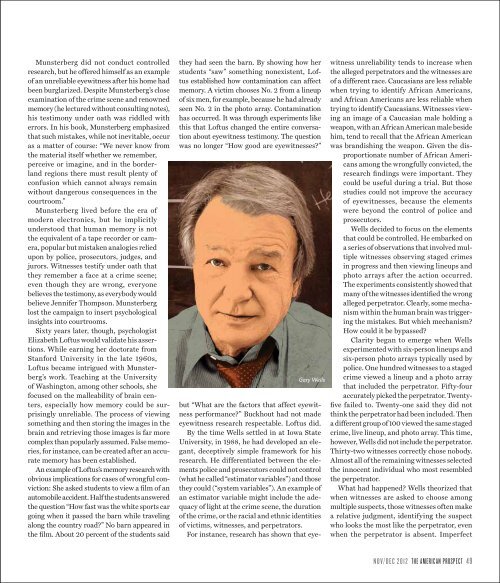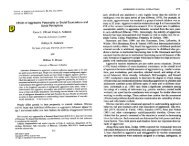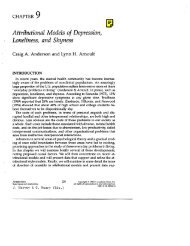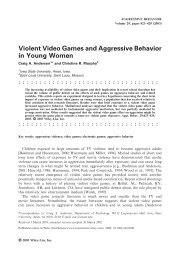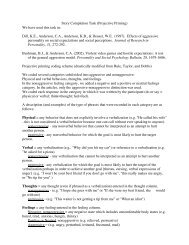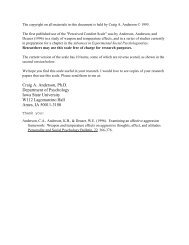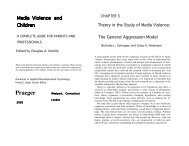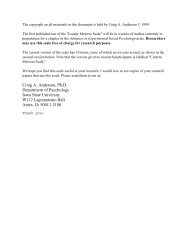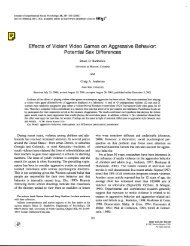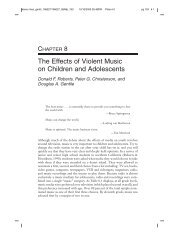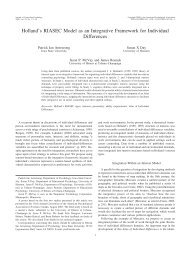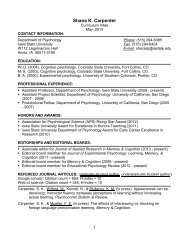Seeing is believing - Department of Psychology - Iowa State University
Seeing is believing - Department of Psychology - Iowa State University
Seeing is believing - Department of Psychology - Iowa State University
You also want an ePaper? Increase the reach of your titles
YUMPU automatically turns print PDFs into web optimized ePapers that Google loves.
Munsterberg did not conduct controlled<br />
research, but he <strong>of</strong>fered himself as an example<br />
<strong>of</strong> an unreliable eyewitness after h<strong>is</strong> home had<br />
been burglarized. Despite Munsterberg’s close<br />
examination <strong>of</strong> the crime scene and renowned<br />
memory (he lectured without consulting notes),<br />
h<strong>is</strong> testimony under oath was riddled with<br />
errors. In h<strong>is</strong> book, Munsterberg emphasized<br />
that such m<strong>is</strong>takes, while not inevitable, occur<br />
as a matter <strong>of</strong> course: “We never know from<br />
the material itself whether we remember,<br />
perceive or imagine, and in the borderland<br />
regions there must result plenty <strong>of</strong><br />
confusion which cannot always remain<br />
without dangerous consequences in the<br />
courtroom.”<br />
Munsterberg lived before the era <strong>of</strong><br />
modern electronics, but he implicitly<br />
understood that human memory <strong>is</strong> not<br />
the equivalent <strong>of</strong> a tape recorder or camera,<br />
popular but m<strong>is</strong>taken analogies relied<br />
upon by police, prosecutors, judges, and<br />
jurors. Witnesses testify under oath that<br />
they remember a face at a crime scene;<br />
even though they are wrong, everyone<br />
believes the testimony, as everybody would<br />
believe Jennifer Thompson. Munsterberg<br />
lost the campaign to insert psychological<br />
insights into courtrooms.<br />
Sixty years later, though, psycholog<strong>is</strong>t<br />
Elizabeth L<strong>of</strong>tus would validate h<strong>is</strong> assertions.<br />
While earning her doctorate from<br />
Stanford <strong>University</strong> in the late 1960s,<br />
L<strong>of</strong>tus became intrigued with Munsterberg’s<br />
work. Teaching at the <strong>University</strong><br />
<strong>of</strong> Washington, among other schools, she<br />
focused on the malleability <strong>of</strong> brain centers,<br />
especially how memory could be surpr<strong>is</strong>ingly<br />
unreliable. The process <strong>of</strong> viewing<br />
something and then storing the images in the<br />
brain and retrieving those images <strong>is</strong> far more<br />
complex than popularly assumed. False memories,<br />
for instance, can be created after an accurate<br />
memory has been establ<strong>is</strong>hed.<br />
An example <strong>of</strong> L<strong>of</strong>tus’s memory research with<br />
obvious implications for cases <strong>of</strong> wrongful conviction:<br />
She asked students to view a film <strong>of</strong> an<br />
automobile accident. Half the students answered<br />
the question “How fast was the white sports car<br />
going when it passed the barn while traveling<br />
along the country road?” No barn appeared in<br />
the film. About 20 percent <strong>of</strong> the students said<br />
they had seen the barn. By showing how her<br />
students “saw” something nonex<strong>is</strong>tent, L<strong>of</strong>tus<br />
establ<strong>is</strong>hed how contamination can affect<br />
memory. A victim chooses No. 2 from a lineup<br />
<strong>of</strong> six men, for example, because he had already<br />
seen No. 2 in the photo array. Contamination<br />
has occurred. It was through experiments like<br />
th<strong>is</strong> that L<strong>of</strong>tus changed the entire conversation<br />
about eyewitness testimony. The question<br />
was no longer “How good are eyewitnesses?”<br />
Gary Wells<br />
but “What are the factors that affect eyewitness<br />
performance?” Buckhout had not made<br />
eyewitness research respectable. L<strong>of</strong>tus did.<br />
By the time Wells settled in at <strong>Iowa</strong> <strong>State</strong><br />
<strong>University</strong>, in 1988, he had developed an elegant,<br />
deceptively simple framework for h<strong>is</strong><br />
research. He differentiated between the elements<br />
police and prosecutors could not control<br />
(what he called “estimator variables”) and those<br />
they could (“system variables”). An example <strong>of</strong><br />
an estimator variable might include the adequacy<br />
<strong>of</strong> light at the crime scene, the duration<br />
<strong>of</strong> the crime, or the racial and ethnic identities<br />
<strong>of</strong> victims, witnesses, and perpetrators.<br />
For instance, research has shown that eyewitness<br />
unreliability tends to increase when<br />
the alleged perpetrators and the witnesses are<br />
<strong>of</strong> a different race. Caucasians are less reliable<br />
when trying to identify African Americans,<br />
and African Americans are less reliable when<br />
trying to identify Caucasians. Witnesses viewing<br />
an image <strong>of</strong> a Caucasian male holding a<br />
weapon, with an African American male beside<br />
him, tend to recall that the African American<br />
was brand<strong>is</strong>hing the weapon. Given the d<strong>is</strong>proportionate<br />
number <strong>of</strong> African Americans<br />
among the wrongfully convicted, the<br />
research findings were important. They<br />
could be useful during a trial. But those<br />
studies could not improve the accuracy<br />
<strong>of</strong> eyewitnesses, because the elements<br />
were beyond the control <strong>of</strong> police and<br />
prosecutors.<br />
Wells decided to focus on the elements<br />
that could be controlled. He embarked on<br />
a series <strong>of</strong> observations that involved multiple<br />
witnesses observing staged crimes<br />
in progress and then viewing lineups and<br />
photo arrays after the action occurred.<br />
The experiments cons<strong>is</strong>tently showed that<br />
many <strong>of</strong> the witnesses identified the wrong<br />
alleged perpetrator. Clearly, some mechan<strong>is</strong>m<br />
within the human brain was triggering<br />
the m<strong>is</strong>takes. But which mechan<strong>is</strong>m?<br />
How could it be bypassed?<br />
Clarity began to emerge when Wells<br />
experimented with six-person lineups and<br />
six-person photo arrays typically used by<br />
police. One hundred witnesses to a staged<br />
crime viewed a lineup and a photo array<br />
that included the perpetrator. Fifty-four<br />
accurately picked the perpetrator. Twentyfive<br />
failed to. Twenty-one said they did not<br />
think the perpetrator had been included. Then<br />
a different group <strong>of</strong> 100 viewed the same staged<br />
crime, live lineup, and photo array. Th<strong>is</strong> time,<br />
however, Wells did not include the perpetrator.<br />
Thirty-two witnesses correctly chose nobody.<br />
Almost all <strong>of</strong> the remaining witnesses selected<br />
the innocent individual who most resembled<br />
the perpetrator.<br />
What had happened? Wells theorized that<br />
when witnesses are asked to choose among<br />
multiple suspects, those witnesses <strong>of</strong>ten make<br />
a relative judgment, identifying the suspect<br />
who looks the most like the perpetrator, even<br />
when the perpetrator <strong>is</strong> absent. Imperfect<br />
nov/dec 2012 The American Prospect 49


